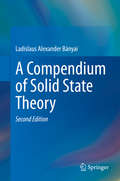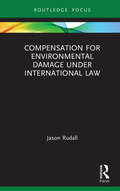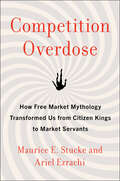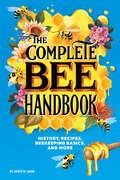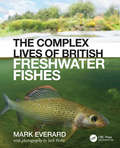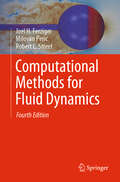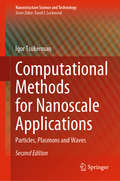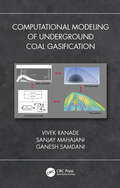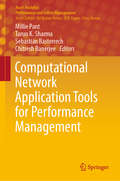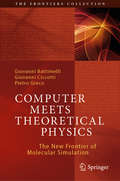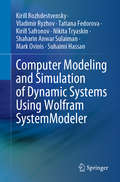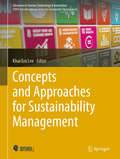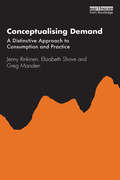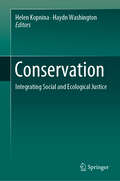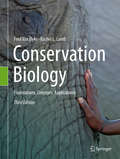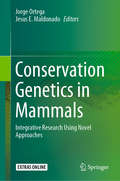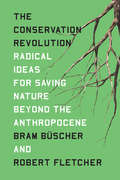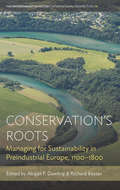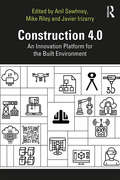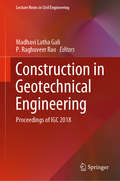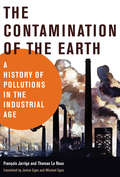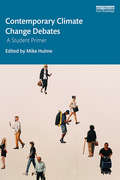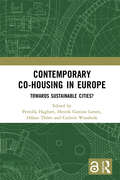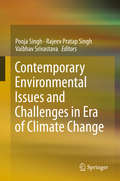- Table View
- List View
A Compendium of Solid State Theory
by Ladislaus Alexander BányaiDesigned to sit alongside more conventional established condensed matter physics textbooks, this compact volume offers a concise presentation of the principles of solid state theory, ideal for advanced students and researchers requiring an overview or a quick refresher on a specific topic.The book starts from the one-electron theory of solid state physics, moving through electron-electron interaction and many-body approximation schemes, to lattice oscillations and their interactions with electrons. Subsequent chapters discuss transport theory and optical properties, phase transitions and some properties of low-dimensional semiconductors. This extensively expanded second edition includes new material on adiabatic perturbation theory, kinetic coefficients, the Nyquist theorem, Bose condensation, and the field-theoretical approach to non-relativistic quantum electrodynamics. Throughout the text, mathematical proofs are often only sketched, and the final chapter of the book reviews some of the key concepts and formulae used in theoretical physics.Aimed primarily at graduate and advanced undergraduate students taking courses on condensed matter theory, the book serves as a study guide to reinforce concepts learned through conventional solid state texts. Researchers and lecturers will also find it a useful resource as a concise set of notes on fundamental topics.
Compensation for Environmental Damage Under International Law (Routledge Research in International Environmental Law)
by Jason RudallInspired by recent litigation, this book identifies and critically appraises the manifold and varied approaches to calculating compensation for damage caused to the environment. It examines a wide range of practice on compensation – in general and specifically for environmental damage – from that of international courts and tribunals, as well as international commissions and regimes, to municipal approaches and other disciplines such as economics and philosophy. Compensation for Environmental Damage Under International Law synthesises these approaches with a view to identifying their blind spots, bringing clarity to an area where there exists broad discrepancy, and charting best practices that appropriately balance the manifold interests at stake. In particular, it is argued that best practice methodologies should ensure compensation serves to fully repair the environment, reflect the emerging ecosystems approach and any implications environmental damage may have for climate change, as well as take into account relevant equitable considerations. This book is essential reading for academics, practitioners and students working in the field of environmental law.
Competition Overdose: How Free Market Mythology Transformed Us from Citizen Kings to Market Servants
by Maurice E. Stucke Ariel EzrachiStucke and Ezrachi’s analysis of the nature of competition is refreshingly non-ideological and counterintuitive. Their idea that competition can be either toxic or noble—all depending on how governments structure markets—is something so clear that it’s remarkable it’s taken us decades to recognize the wisdom of it. This is a must-read for anyone interested in how to use public policy to harness the competitive drive for the public good. — Chris Hughes, cofounder of FacebookStucke and Ezrachi show us the important differences between destructive and noble competition and what we can do to pursue a more just and prosperous world. This book changes how you will view the role of the market in our economy and society at large. — Spencer Weber Waller, director of the Institute for Consumer Antitrust Studies and law professor at Loyola University ChicagoEntertaining and thought-provoking, Competition Overdose fiercely articulates the raw, hard truth behind the toxic aspects of competition. — Tommaso Valletti, professor of economics at Imperial College London and Chief Competition Economist (2016–2019), European CommissionCompetition Overdose is probably the most important book to be published on the subject since The Antitrust Paradox hit the bookshelves in 1978. It is destined to transform how governments across the world think about the role competition in domestic and international policy for decades to come. Stucke and Ezrachi are the new rock stars of competition policy. — Ali Nikpay, partner at Gibson Dunn & CrutcherAnything, in the wrong dosage, can be poisonous. Competition Overdose takes a sacred cow of contemporary western thought—that ‘more competition is always good’—and reveals that while competition can be noble, it can also be toxic. An engaging and compelling read that will make you think differently about situations we all deal with every day. — Tim Wu, professor at Columbia Law School, contributing opinion writer for the New York Times, and author of The Master Switch and The Attention MerchantsA must-read for anyone concerned about the future of our economy and society, Competition Overdose provides a no-nonsense analysis of how toxic competition can be bad for competitors, consumers, workers, and society overall. The authors highlight the abuses of this ideology and remind us that we, as citizens and consumers, can exercise our power by choosing products, based on our values. — Monique Goyens, director general of BEUC, The European Consumer OrganisationThis beautifully written book helps us rethink economic principles from the ground up. As any good chemist knows, what can be helpful or harmless in small doses is deadly in excess. While technocrats push competition as a cure to all economic ailments, Stucke and Ezrachi deliver a dose of reality: cutthroat schemes to kneecap rivals, manipulate customers, and exploit workers harm far more than they help. Read this book for a brilliant account of the proper place of competition (and ethics) in society. — Frank Pasquale, law professor at University of Maryland and author of The Black Box SocietyStucke and Ezrachi examine a multitude of perversities in today’s society—colleges striving to recruit applicants they likely will reject, supermarkets stocking hundreds of varieties of jam, travel deals stuffed with hidden fees—and provide a unifying explanation: a misalignment of competition. Their book illuminates how competition can go wrong, and how individuals, businesses, and the government can set it right. — Jonathan Levin, dean of Stanford Graduate School of BusinessIs more competition the solution to all our societal problems? Stucke and Ezrachi persuasively say: No, it depends; sometimes we need to rein in markets because they prod
The Complete Bee Handbook: History, Recipes, Beekeeping Basics, and More
by Dewey M. CaronA guide to the history, behavior, and bounty of the humble bee From backyard keeping to bee-centric foods and home goods, there's no end to humankind's fascination with bees. The Complete Bee Handbook is a compelling read and easy-to-use reference, packed with practical and thought-provoking information for bee lovers new and old. Journey through the past, present, and future of the bee, including their evolution, their ever-critical role as pollinators, and the ongoing threats that jeopardize their survival. You'll also discover a short and sweet cultural history of beekeeping, the numerous applications of bee products, and tips on how you can support your local bee population. This bee guide explores: The life of the honey bee—Look into the mind of the hive as you learn about the role each bee plays in helping their colony function and thrive. Beekeeping for beginners—Get simple advice for cultivating a bee-friendly garden, from preferred plants to fun DIY accessories. Buzzworthy recipes—Try your hand at creative recipes for bee lovers, including mead, baklava, beeswax soap, and candles. Discover everything you wanted to know about bees with The Complete Bee Handbook!
The Complex Lives of British Freshwater Fishes
by Mark EverardThis stunningly illustrated book goes far beyond a run-of-the-mill nature guide. It explores the fascinating life histories of Britain’s freshwater fishes, a group of animals which, despite their importance and ubiquity in our diverse still and flowing fresh waters, has before now been rarely regarded and respected as 'wildlife'. Our native fishes tend generally to be considered as simply something for anglers to catch or for people to eat, yet they work enormously hard for us. Author Mark Everard, avid nature-watcher, angler and scientist, shows how freshwater fish provide food, ornamentation, sport and cultural identity, and highlights their huge importance for conservation as part of the living ecosystems upon which we all depend. He dives into the mysteries moving below the surface of our rivers and lakes, bringing the wonderful and fascinating world of the diversity of British freshwater fish species into plain sight and into mind. This unique book features over 100 full-colour photographs by pioneering photographer and filmmaker Jack Perks, whose work has featured on BBC Springwatch, The One Show and Countryfile. The book is filled with technical detail useful to conservationists and biology students. Most importantly, it is also presented in an accessible, visually attractive and engaging manner that will appeal to anybody with an interest in the natural world: the conservation-minded public, the angling community, and our nation of wildlife enthusiasts. Whatever your background, this book will open your eyes to our freshwater fishy wealth, and the many ways in which it enriches our lives.
Computational Methods for Fluid Dynamics
by Joel H. Ferziger Milovan Perić Robert L. StreetThis book is a guide to numerical methods for solving fluid dynamics problems. The most widely used discretization and solution methods, which are also found in most commercial CFD-programs, are described in detail. Some advanced topics, like moving grids, simulation of turbulence, computation of free-surface flows, multigrid methods and parallel computing, are also covered. Since CFD is a very broad field, we provide fundamental methods and ideas, with some illustrative examples, upon which more advanced techniques are built. Numerical accuracy and estimation of errors are important aspects and are discussed in many examples. Computer codes that include many of the methods described in the book can be obtained online. This 4th edition includes major revision of all chapters; some new methods are described and references to more recent publications with new approaches are included. Former Chapter 7 on solution of the Navier-Stokes equations has been split into two Chapters to allow for a more detailed description of several variants of the Fractional Step Method and a comparison with SIMPLE-like approaches. In Chapters 7 to 13, most examples have been replaced or recomputed, and hints regarding practical applications are made. Several new sections have been added, to cover, e.g., immersed-boundary methods, overset grids methods, fluid-structure interaction and conjugate heat transfer.
Computational Methods for Nanoscale Applications: Particles, Plasmons and Waves (Nanostructure Science and Technology)
by Igor TsukermanPositioning itself at the common boundaries of several disciplines, this work provides new perspectives on modern nanoscale problems where fundamental science meets technology and computer modeling. In addition to well-known computational techniques such as finite-difference schemes and Ewald summation, the book presents a new finite-difference calculus of Flexible Local Approximation Methods (FLAME) that qualitatively improves the numerical accuracy in a variety of problems.
Computational Modeling of Underground Coal Gasification
by Vivek V. Ranade Sanjay M Mahajani Ganesh Arunkumar SamdaniThe book deals with development of comprehensive computational models for simulating underground coal gasification (UCG). It starts with an introduction to the UCG process and process modelling inputs in the form of reaction kinetics, flow patterns, spalling rate, and transport coefficient that are elaborated with methods to generate the same are described with illustrations. All the known process models are reviewed, and relative merits and limitations of the modeling approaches are highlighted and compared. The book describes all the necessary steps required to determine the techno-economic feasibility of UCG process for a given coal reserve, through modeling and simulation.
Computational Network Application Tools for Performance Management (Asset Analytics)
by Millie Pant Tarun K. Sharma Sebastián Basterrech Chitresh BanerjeeThis book explores a range of important theoretical and practical issues in the field of computational network application tools, while also presenting the latest advances and innovations using intelligent technology approaches. The main focus is on detecting and diagnosing complex application performance problems so that an optimal and expected level of system service can be attained and maintained. The book discusses challenging issues like enhancing system efficiency, performance, and assurance management, and blends the concept of system modeling and optimization techniques with soft computing, neural network, and sensor network approaches. In addition, it presents certain metrics and measurements that can be translated into business value. These metrics and measurements can also help to establish an empirical performance baseline for various applications, which can be used to identify changes in system performance. By presenting various intelligent technologies, the book provides readers with compact but insightful information on several broad and rapidly growing areas in the computation network application domain.The book’s twenty-two chapters examine and address current and future research topics in areas like neural networks, soft computing, nature-inspired computing, fuzzy logic and evolutionary computation, machine learning, smart security, and wireless networking, and cover a wide range of applications from pattern recognition and system modeling, to intelligent control problems and biomedical applications. The book was written to serve a broad readership, including engineers, computer scientists, management professionals, and mathematicians interested in studying tools and techniques for computational intelligence and applications for performance analysis. Featuring theoretical concepts and best practices in computational network applications, it will also be helpful for researchers, graduate and undergraduate students with an interest in the fields of soft computing, neural networks, machine learning, sensor networks, smart security, etc.
Computer Meets Theoretical Physics: The New Frontier of Molecular Simulation (The Frontiers Collection)
by Giovanni Battimelli Giovanni Ciccotti Pietro GrecoThis book provides a vivid account of the early history of molecular simulation, a new frontier for our understanding of matter that was opened when the demands of theoretical physicists were met by the availability of the modern computers. Since their inception, electronic computers have enormously increased their performance, thus making possible the unprecedented technological revolution that characterizes our present times. This obvious technological advancement has brought with it a silent scientific revolution in the practice of theoretical physics. In particular, in the physics of matter it has opened up a direct route from the microscopic physical laws to observable phenomena. One can now study the time evolution of systems composed of millions of molecules, and simulate the behaviour of macroscopic materials and actually predict their properties. Molecular simulation has provided a new theoretical and conceptual tool that physicists could only dream of when the foundations of statistical mechanics were laid. Molecular simulation has undergone impressive development, both in the size of the scientific community involved and in the range and scope of its applications. It has become the ubiquitous workhorse for investigating the nature of complex condensed matter systems in physics, chemistry, materials and the life sciences. Yet these developments remain largely unknown outside the inner circles of practitioners, and they have so far never been described for a wider public. The main objective of this book is therefore to offer a reasonably comprehensive reconstruction of the early history of molecular simulation addressed to an audience of both scientists and interested non-scientists, describing the scientific and personal trajectories of the main protagonists and discussing the deep conceptual innovations that their work produced.
Computer Modeling and Simulation of Dynamic Systems Using Wolfram SystemModeler
by Shaharin Anwar Sulaiman Kirill Rozhdestvensky Vladimir Ryzhov Tatiana Fedorova Kirill Safronov Nikita Tryaskin Mark Ovinis Suhaimi HassanThis book briefly discusses the main provisions of the theory of modeling. It also describes in detail the methodology for constructing computer models of dynamic systems using the Wolfram visual modeling environment, SystemModeler, and provides illustrative examples of solving problems of mechanics and hydraulics. Intended for students and professionals in the field, the book also serves as a supplement to university courses in modeling and simulation of dynamic systems.
Concepts and Approaches for Sustainability Management (Advances in Science, Technology & Innovation)
by Khai Ern LeeWith the introduction of the 2030 Agenda for Sustainable Development by the United Nations General Assembly in 25 September 2015, UN agencies, member states and stakeholders have begun to focus on the adoption and implementation of these strategies in realization of 17 Sustainable Development Goals. To work toward sustainability, strategic measures to encourage stakeholders to contribute to the goals of the 2030 agenda are needed. In recognition of these efforts, this book is produced to compile research concepts and approaches for the area of sustainability management of industry, technology development, community, education and the environment. The objective of this book is to deliberate concepts and approaches of sustainability management taking place in Malaysia whereby case studies will be revealed to provide way forward of sustainability management toward achieving sustainable development. The insights provided can be applied to advanced and developing countries by sustainable development practitioners, encompassing government agencies, academia, industries, NGOs and community, who would like to adopt the concept of approach of sustainability into their area of management.
Conceptualising Demand: A Distinctive Approach to Consumption and Practice
by Jenny Rinkinen Elizabeth Shove Greg MarsdenThis book addresses fundamental questions about the very idea of demand: how is it constituted, how does it change and how might it be steered? Conceptualising Demand focuses on five core propositions: that demand is derived from social practices; that it is made and not simply met; that it is materially embedded and temporally unfolding; and that it is modulated through many forms of policy and governance. In working through these claims, the book weaves concepts from the sociology of consumption, science and technology studies, policy analyses and social theories of practice together with empirical cases and new research into such topics as the rise of refrigerated foods, the emergence of online shopping and the transformation of energy demanding services. This innovative book takes a fresh look at the very idea of demand, a concept that is often taken for granted, but that is vital for scholars and students of energy, mobility, climate change and consumption, and anyone interested in the subject.
Condor Comeback (Scientists in the Field Series)
by Sy MontgomerySibert Medalist, National Book Award Honoree, and New York Times best-selling author Sy Montgomery turns her formidable talents to the story of California condors and the scientists who have fought against their extinction in this installment in the award-winning Scientists in the Field series. In April of 1987 the last wild California condor was captured and taken to live in captivity like the other twenty-six remaining birds of its kind. Many thought that the days were over of of this remarkable, distinguished bird that had roamed the skies of North and Central American for thousands of years. Sy Montgomery employs her skill for on-the-ground reporting, shrewd observation, and stunning narrative prose to detail the efforts of scientists, volunteers, and everyday citizens to get California condors back in the wild. In particular, Montgomery profiles employees at the Santa Barbara Zoo who have worked tirelessly to raise abandoned chicks, nurse sick birds back to health, and conduct research that can support legislation to ban what is probably the largest threat to the existence of the wild condor: lead bullets. In turns affectionate and frustrated, hopeful and heartbreaking, Montgomery&’s powerful prose does justice to these ancient, sociable, and elegant creatures. Complete with world-class, full-color photography and helpful sidebars that provide details such as the history of the bird&’s fight back from extinction, the dangers of lead poisoning, and the relationship of condors to the Chumash nation, Condor Comeback is an inspiring story of groundbreaking science, perseverance, and cooperation.
Conservation: Integrating Social and Ecological Justice (Routledge Explorations In Environmental Studies)
by Helen Kopnina Haydn WashingtonThis book provides keys to decrypt current political debates on the environment in light of the theories that support them, and provides tools to better understand and manage environmental conflicts and promote environmentally friendly behaviour. As we work towards global sustainability at a time when efforts to conserve biodiversity and combat climate change correspond with land grabs by large corporations, food insecurity, and human displacement. While we seek to reconcile more-than-human relations and responsibilities in the Anthropocene, we also struggle to accommodate social justice and the increasingly global desire for economic development. These and other challenges fundamentally alter the way social scientists relate to communities and the environment. This book takes as its point of departure today’s pressing environmental challenges, particularly the loss of biodiversity, and the role of communities in protected areas conservation. In its chapters, the authors discuss areas of tension between local livelihoods and international conservation efforts, between local communities and wildlife, and finally between traditional ways of living and ‘modernity’. The central premise of this book is while these tensions cannot be easily resolved they can be better understood by considering both social and ecological effects, in equal measure. While environmental problems cannot be seen as purely ecological because they always involve people, who bring to the environmental table their different assumptions about nature and culture, so are social problems connected to environmental constraints. While nonhumans cannot verbally bring anything to this negotiating table, aside from vast material benefits that society relies on, the distinct perspective of this book is that there is a need to consider the role of nonhumans as equally important stakeholders – albeit without a voice. This book develops an argument that human-environmental relationships are set within ecological reality and ecological ethics and rather than being mutually constitutive processes, humans have obligate dependence on nature, not vice versa. This would enable an ethical position encompassing the needs of other species and giving simultaneous (without one being subordinated to another) consideration to justice for humans and non-humans alike. The book is accessible to both social scientists and conservation specialists, and intends to contribute to strengthening interdisciplinary collaborations in the field of conservation.
Conservation Biology: Foundations, Concepts, Applications
by Rachel L. Lamb Fred Van DykeThis book provides a thorough, up-to-date examination of conservation biology and the many supporting disciplines that comprise conservation science. In this, the Third Edition of the highly successful Conservation Biology: Foundations, Concepts, Applications, the authors address their interdisciplinary topic as it must now be practiced and perceived in the modern world. Beginning with a concise review of the history of conservation, the authors go on to explore the interplay of conservation with genetics, demography, habitat and landscape, aquatic environments, and ecosystem management, and the relationship of all these disciplines to ethics, economics, law, and policy. An entirely new chapter, The Anthropocene: Conservation in a Human-Dominated Nature, breaks new ground in its exploration of how conservation can be practiced in anthropogenic biomes, novel ecosystems, and urban habitats. The Third Edition includes the popular Points of Engagement discussion questions used in earlier editions, and adds a new feature: Information Boxes, which briefly recap specific case histories described in the text. A concluding chapter offers insight into how to become a conservation professional, in both traditional and non-traditional roles.The authors, Fred Van Dyke and Rachel Lamb, draw on their expertise as field biologists, wildlife managers, consultants to government and industry, and scholars of environmental law, policy, and advocacy, as well as their many years of effective teaching experience. Informed by practical knowledge and acquired skills, the authors have created a work of exceptional clarity and readability which encompasses both systemic foundations as well as contemporary developments in the field. Conservation Biology: Foundations, Concepts, Applications will be of invaluable benefit to undergraduate and graduate students, as well as to working conservation scientists and managers.This is an amazing resource for students, faculty, and practitioners both new and experienced to the field. Diane Debinski, PhD Unexcelled wisdom for living at home on Wonderland Earth, the planet with promise, destined for abundant life. Holmes Rolston, PhDVan Dyke and Lamb have maintained the original text’s emphasis on connecting classical ecological and environmental work with updated modern applications and lucid examples. But more importantly, the third edition contains much new material on the human side of conservation, including expanded treatments of policy, economics, and climate change. Tim Van Deelen, PhD Fred Van Dyke and Rachel Lamb break new ground in both the breadth and depth of their review and analysis of this crucially important and rapidly changing field. Any student or other reader wishing to have a comprehensive overview and understanding of the complexities of conservation biology need look no further – this book is your starting point! Simon N. Stuart, PhDAnyone who teaches, talks or writes and works on Conservation Biology, needs this latest edition of Conservation Biology (Foundations, Concepts, Applications, 3rd edition) by Fred Van Dyke and Rachel L. Lamb. This will be useful to both beginners and experts as well. The authors included almost all important issues in relation to conservation biology. This is really an outstanding book. Bidhan Chandra Das, Professor, Ecology Branch, Department of Zoology, University of Rajshahi, Bangladesh
Conservation Genetics in Mammals: Integrative Research Using Novel Approaches
by Jorge Ortega Jesus E. MaldonadoThis book focuses on the use of molecular tools to study small populations of rare and endangered mammals, and presents case studies that apply an evolutionary framework to address innovative questions in the emerging field of mammalian conservation genomics using a highly diverse set of novel molecular tools. Novel and more precise molecular technologies now allow experts in the field of mammology to interpret data in a more contextual and empirical fashion and to better describe the evolutionary and ecological processes that are responsible for the patterns they observe. The book also demonstrates how recent advances in genetic/genomic technologies have been applied to assess the impact of environmental/anthropogenic changes on the health of small populations of mammals. It examines a range of issues in the field of mammalian conservation genomics, such as the role that the genetic diversity of the immune system plays in disease protection and local adaptation; the use of noninvasive techniques and genomic banks as a resource for monitoring and restoring populations; the structuring of population by physical barriers; and genetic diversity. Further, by integrating research from a variety of areas – including population genetics, molecular ecology, systematics, and evolutionary and conservation biology – it enables readers to gain a deeper understanding of the conservation biology of mammals that are at increasing risk of extinction at local, regional and global scales. As such, it offers a unique resource for a broad readership interested in the conservation biology of mammals and conservation management strategies to better preserve biodiversity.
The Conservation Revolution: Radical Ideas for Saving Nature Beyond the Anthropocene
by Bram Buscher Robert FletcherA post-capitalist manifesto for conservationConservation needs a revolution. This is the only way it can contribute to the drastic transformations needed to come to a truly sustainable model of development. The good news is that conservation is ready for revolution. Heated debates about the rise of the Anthropocene and the current &‘sixth extinction&’ crisis demonstrate an urgent need and desire to move beyond mainstream approaches. Yet the conservation community is deeply divided over where to go from here. Some want to place &‘half earth&’ into protected areas. Others want to move away from parks to focus on unexpected and &‘new&’ natures. Many believe conservation requires full integration into capitalist production processes. Building a razor-sharp critique of current conservation proposals and their contradictions, Büscher and Fletcher argue that the Anthropocene challenge demands something bigger, better and bolder. Something truly revolutionary. They propose convivial conservation as the way forward. This approach goes beyond protected areas and faith in markets to incorporate the needs of humans and nonhumans within integrated and just landscapes. Theoretically astute and practically relevant, The Conservation Revolution offers a manifesto for conservation in the twenty-first century—a clarion call that cannot be ignored.
Conservation’s Roots: Managing for Sustainability in Preindustrial Europe, 1100–1800 (Environment in History: International Perspectives #19)
by Abigail P. Dowling Richard KeyserThe ideas and practices that comprise “conservation” are often assumed to have arisen within the last two centuries. However, while conservation today has been undeniably entwined with processes of modernity, its historical roots run much deeper. Considering a variety of preindustrial European settings, this book assembles case studies from the medieval and early modern eras to demonstrate that practices like those advocated by modern conservationists were far more widespread and intentional than is widely acknowledged. As the first book-length treatment of the subject, Conservation’s Roots provides broad social, historical, and environmental context for the emergence of the nineteenth-century conservation movement.
Construction 4.0: An Innovation Platform for the Built Environment
by Anil Sawhney Michael Riley Javier IrizarryModelled on the concept of Industry 4.0, the idea of Construction 4.0 is based on a confluence of trends and technologies that promise to reshape the way built environment assets are designed, constructed, and operated. With the pervasive use of Building Information Modelling (BIM), lean principles, digital technologies, and offsite construction, the industry is at the cusp of this transformation. The critical challenge is the fragmented state of teaching, research, and professional practice in the built environment sector. This handbook aims to overcome this fragmentation by describing Construction 4.0 in the context of its current state, emerging trends and technologies, and the people and process issues that surround the coming transformation. Construction 4.0 is a framework that is a confluence and convergence of the following broad themes discussed in this book: Industrial production (prefabrication, 3D printing and assembly, offsite manufacture) Cyber-physical systems (actuators, sensors, IoT, robots, cobots, drones) Digital and computing technologies (BIM, video and laser scanning, AI and cloud computing, big data and data analytics, reality capture, Blockchain, simulation, augmented reality, data standards and interoperability, and vertical and horizontal integration) The aim of this handbook is to describe the Construction 4.0 framework and consequently highlight the resultant processes and practices that allow us to plan, design, deliver, and operate built environment assets more effectively and efficiently by focusing on the physical-to-digital transformation and then digital-to-physical transformation. This book is essential reading for all built environment and AEC stakeholders who need to get to grips with the technological transformations currently shaping their industry, research, and teaching.
Construction in Geotechnical Engineering: Proceedings of IGC 2018 (Lecture Notes in Civil Engineering #84)
by Madhavi Latha Gali P. Raghuveer RaoThis volume comprises select papers presented during the Indian Geotechnical Conference 2018. This volume discusses construction challenges and issues in geotechnical engineering. The contents cover foundation design and analysis, issues related to geotechnical structures, including dams, retaining walls, embankments and pavements, and rock mechanics and construction in rocks and rocky environments. Many of the papers discuss live case studies related to important geotechnical engineering projects worldwide, providing useful insights into the realistic designs and constructions. This volume will be of interest to students, researchers and practitioners alike.
The Contamination of the Earth: A History of Pollutions in the Industrial Age (History for a Sustainable Future)
by Francois Jarrige Thomas Le RouxThe trajectories of pollution in global capitalism, from the toxic waste of early tanneries to the poisonous effects of pesticides in the twentieth century.Through the centuries, the march of economic progress has been accompanied by the spread of industrial pollution. As our capacities for production and our aptitude for consumption have increased, so have their byproducts—chemical contamination from fertilizers and pesticides, diesel emissions, oil spills, a vast “plastic continent” found floating in the ocean. The Contamination of the Earth offers a social and political history of industrial pollution, mapping its trajectories over three centuries, from the toxic wastes of early tanneries to the fossil fuel energy regime of the twentieth century.The authors describe how, from 1750 onward, in contrast to the early modern period, polluted water and air came to be seen as inevitable side effects of industrialization, which was universally regarded as beneficial. By the nineteenth century, pollutants became constituent elements of modernity. The authors trace the evolution of these various pollutions, and describe the ways in which they were simultaneously denounced and permitted. The twentieth century saw new and massive scales of pollution: chemicals that resisted biodegradation, including napalm and other defoliants used as weapons of war; the ascendancy of oil; and a lifestyle defined by consumption. In the 1970s, pollution became a political issue, but efforts—local, national, and global—to regulate it often fell short. Viewing the history of pollution though a political lens, the authors also offer lessons for the future of the industrial world.
Contemporary Climate Change Debates: A Student Primer
by Mike HulmeContemporary Climate Change Debates is an innovative new textbook which tackles some of the difficult questions raised by climate change. For the complex policy challenges surrounding climate migration, adaptation and resilience, structured debates become effective learning devices for students. This book is organised around 15 important questions, and is split into four parts: What do we need to know? What should we do? On what grounds should we base our actions? Who should be the agents of change? Each debate is addressed by pairs of one or two leading or emerging academics who present opposing viewpoints. Through this format the book is designed to introduce students of climate change to different arguments prompted by these questions, and also provides a unique opportunity for them to engage in critical thinking and debate amongst themselves. Each chapter concludes with suggestions for further reading and with discussion questions for use in student classes. Drawing upon the sciences, social sciences and humanities to debate these ethical, cultural, legal, social, economic, technological and political roadblocks, Contemporary Debates on Climate Change is essential reading for all students of climate change, as well as those studying environmental policy and politics and sustainable development more broadly.
Contemporary Co-housing in Europe (Open Access): Towards Sustainable Cities?
by Hakan Thorn Henrik Gutzon Larsen Cathrin Wasshede Pernilla HagbertThis book investigates co-housing as an alternative housing form in relation to sustainable urban development. Co-housing is often lauded as a more sustainable way of living. The primary aim of this book is to critically explore co-housing in the context of wider social, economic, political and environmental developments. This volume fills a gap in the literature by contextualising co-housing and related housing forms. With focus on Denmark, Sweden, Hamburg and Barcelona, the book presents general analyses of co-housing in these contexts and provides specific discussions of co-housing in relation to local government, urban activism, family life, spatial logics and socio-ecology. This book will be of interest to students and researchers in a broad range of social-scientific fields concerned with housing, urban development and sustainability, as well as to planners, decision-makers and activists.
Contemporary Environmental Issues and Challenges in Era of Climate Change
by Pooja Singh Rajeev Pratap Singh Vaibhav SrivastavaOver the last few decades, unprecedented global population growth has led to increased demand for food and shelter. At the same time, extraction of natural resources beyond the Earth’s resilience capacity has had a devastating effect on ecosystems and environmental health. Furthermore, climate change is having a significant impact in a number of areas, including the global hydrological cycle, ecosystem functioning, coastal vulnerability, forest ecology, food security, and agricultural sustainability. According to the Intergovernmental Panel on Climate Change (IPCC), only immediate and sustained action will prevent climate change causing irreversible and potentially catastrophic damage to our environment. This book presents various scientific views and concepts, research, reviews, and case studies on contemporary environmental issues in changing climate scenarios and highlights different adaptation measures. Increasing awareness of modern-day patterns of climate change, it addresses questions often raised by environmental scientists, researchers, policymakers and general readers.
